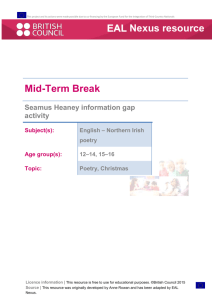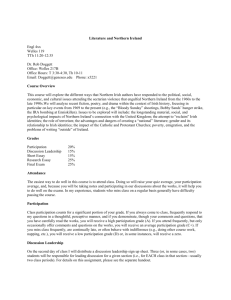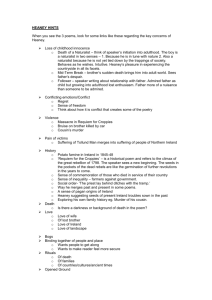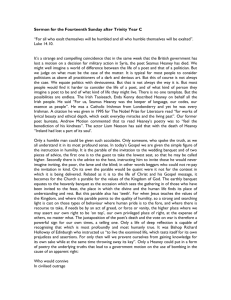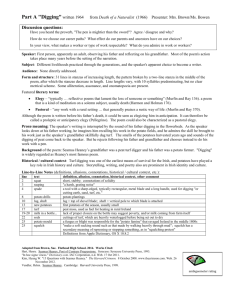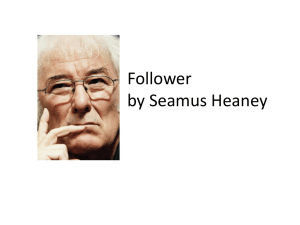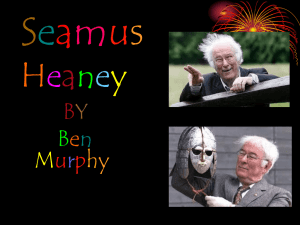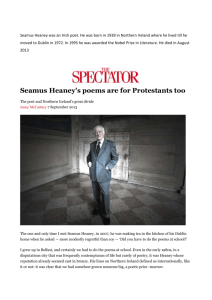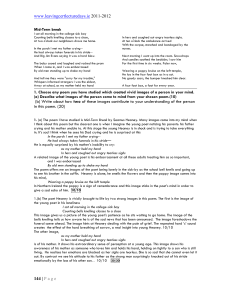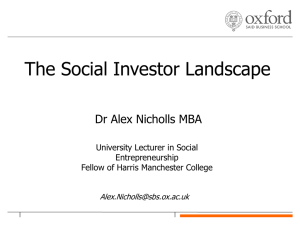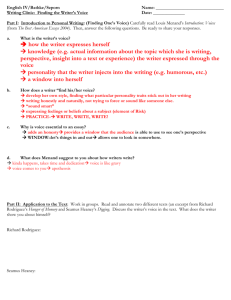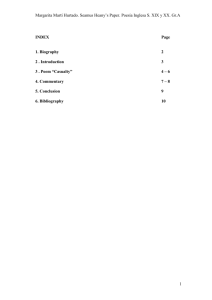seminar demo
advertisement
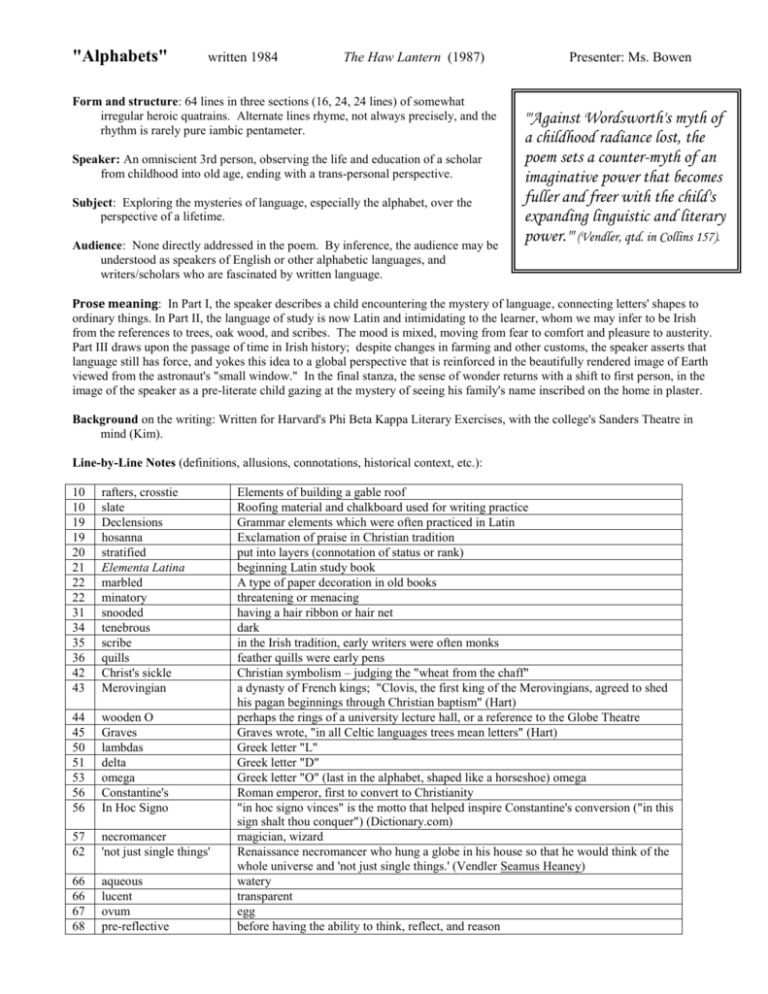
"Alphabets" written 1984 The Haw Lantern (1987) Form and structure: 64 lines in three sections (16, 24, 24 lines) of somewhat irregular heroic quatrains. Alternate lines rhyme, not always precisely, and the rhythm is rarely pure iambic pentameter. Speaker: An omniscient 3rd person, observing the life and education of a scholar from childhood into old age, ending with a trans-personal perspective. Subject: Exploring the mysteries of language, especially the alphabet, over the perspective of a lifetime. Audience: None directly addressed in the poem. By inference, the audience may be understood as speakers of English or other alphabetic languages, and writers/scholars who are fascinated by written language. Presenter: Ms. Bowen "'Against Wordsworth's myth of a childhood radiance lost, the poem sets a counter-myth of an imaginative power that becomes fuller and freer with the child's expanding linguistic and literary power.'" (Vendler, qtd. in Collins 157). Prose meaning: In Part I, the speaker describes a child encountering the mystery of language, connecting letters' shapes to ordinary things. In Part II, the language of study is now Latin and intimidating to the learner, whom we may infer to be Irish from the references to trees, oak wood, and scribes. The mood is mixed, moving from fear to comfort and pleasure to austerity. Part III draws upon the passage of time in Irish history; despite changes in farming and other customs, the speaker asserts that language still has force, and yokes this idea to a global perspective that is reinforced in the beautifully rendered image of Earth viewed from the astronaut's "small window." In the final stanza, the sense of wonder returns with a shift to first person, in the image of the speaker as a pre-literate child gazing at the mystery of seeing his family's name inscribed on the home in plaster. Background on the writing: Written for Harvard's Phi Beta Kappa Literary Exercises, with the college's Sanders Theatre in mind (Kim). Line-by-Line Notes (definitions, allusions, connotations, historical context, etc.): 10 10 19 19 20 21 22 22 31 34 35 36 42 43 rafters, crosstie slate Declensions hosanna stratified Elementa Latina marbled minatory snooded tenebrous scribe quills Christ's sickle Merovingian 44 45 50 51 53 56 56 wooden O Graves lambdas delta omega Constantine's In Hoc Signo 57 62 necromancer 'not just single things' 66 66 67 68 aqueous lucent ovum pre-reflective Elements of building a gable roof Roofing material and chalkboard used for writing practice Grammar elements which were often practiced in Latin Exclamation of praise in Christian tradition put into layers (connotation of status or rank) beginning Latin study book A type of paper decoration in old books threatening or menacing having a hair ribbon or hair net dark in the Irish tradition, early writers were often monks feather quills were early pens Christian symbolism – judging the "wheat from the chaff" a dynasty of French kings; "Clovis, the first king of the Merovingians, agreed to shed his pagan beginnings through Christian baptism" (Hart) perhaps the rings of a university lecture hall, or a reference to the Globe Theatre Graves wrote, "in all Celtic languages trees mean letters" (Hart) Greek letter "L" Greek letter "D" Greek letter "O" (last in the alphabet, shaped like a horseshoe) omega Roman emperor, first to convert to Christianity "in hoc signo vinces" is the motto that helped inspire Constantine's conversion ("in this sign shalt thou conquer") (Dictionary.com) magician, wizard Renaissance necromancer who hung a globe in his house so that he would think of the whole universe and 'not just single things.' (Vendler Seamus Heaney) watery transparent egg before having the ability to think, reflect, and reason 69 70 71 agog gable trowel very excited peak of a building's wall tool for spreading plaster or mortar Key literary criticism: Floyd Collins: "In his first book, Death of a Naturalist, Heaney dramatized his development as a vessel of poetic consciousness, an impressionable child overwhelmed by the natural universe. 'Alphabets,' on the other hand, depicts a world scaled down to a miniaturist's fairy-tale dimensions. Far from being reductive, it is the poem of an adult who continues to perceive magic in the ageless ciphers. Helen Vendler locates in 'Alphabets' a clever inversion of Heaney's early Wordsworthian approach: 'Against Wordsworth's myth of a childhood radiance lost, the poem sets a countermyth of an imaginative power that becomes fuller and freer with the child's expanding linguistic and literary power.'" Matthew Campbell: "In 'Alphabets,' Heaney's own education recapitulates the development of modern man – from the farm and its simple technology to the sophistication that would send us into space and provide us a new view of our planet. The alienation from the source created by education and travel can also bring us back to an astonished sense of the miracle and strangeness of growth and life, from beginning to end, from alpha to omega." Theme: going from "the earth of farm labour to the heaven of education" ("Seamus Heaney – Biography") Themes of silence/voice, speaking for self and others, and innocence/experience ("Studying Seamus Heaney") "It’s a child’s-eye view of language, from the first letters in chalk, through the Latin and Gaelic of boyhood, to the sense of wordless wonder that survives adulthood." (Ireland) Key literary elements & discussion: Motif/Symbol: the letter "O" and the shape of the globe and the sound of awe Rhyme and rhythm variations: Heroic quatrains with predominately slant rhyme (assonance or consonance) and irregular scansion. Because the irregularities are the rule in this poem, the regular moments stand out by exception. Imagery varied subjects and levels of detail, from farm life to school to cosmos Syntax varies from simple ("This is writing." 3) to the 8-line sprawling sentence at the end Verb tense shifts from past to present (35) Context (compare/contrast to other Heaney poems): Echoes self-reflection of the writer in "Digging." ("Seamus Heaney – Biography") Themes of continuity of the Irish experience and examples of Heaney’s fascination with the past run through much of his poetry (Brown). Presenter's arguable thesis: In the poem "Alphabets," Seamus Heaney uses a three-part structure, a tone of wonder, and the motif of the "O" shape to parallel the human journey through history with the poet's journey through the mysteries of language. Bibliography: Brown, Sue. "Digging." Monograph. 2011. Campbell, Matthew. The Cambridge Companion to Contemporary Irish Poetry. Cambridge: Cambridge University Press, 2003. GoogleBooks 27 November 2012. Collins, Floyd. Seamus Heaney: The Crisis of Identity. Cranbury: Rosemount Publishing, 2003. GoogleBooks 27 November 2012. Hart, Henry. Seamus Heaney, Poet of Contrary Progressions. Syracuse: Syracuse University Press, 1993. "Heroic Stanza." Encyclopædia Britannica. Encyclopædia Britannica Online. Encyclopædia Britannica, 2011. Web. 17 Oct. 2011. "In hoc signo vinces." Dictionary.com. IAC Corporation, n.d. Web. 17 Oct 2011. Ireland, Corydon. "Heaney 'catches the Heart off Guard'" Harvard Gazette. N.p., 2 October 2008. Web. 26 Nov. 2012. http://news.harvard.edu/ Kim, Hyung W. "15 Questions with Seamus Heaney." The Harvard Crimson. 8 October 2008. www.thecrimson.com. Web. 26 November 2012. "Seamus Heaney - Biography". Nobelprize.org. 27 Nov 2012. from From Les Prix Nobel. The Nobel Prizes 1995, Editor Tore Frängsmyr, [Nobel Foundation], Stockholm, 1996. "Studying Seamus Heaney." Meredith College : Raleigh, NC. N.p., n.d. Web. 26 Nov. 2012. www.meredith.edu/english/heaney/crit.htm Tobin, Daniel. Passage to the center: imagination and the sacred in the poetry of Seamus Heaney. Lexington: University Press of Kentucky, 1999. Vendler, Helen Hennessy. Soul says: on recent poetry. Cambridge: Belknap Press of Harvard University Press, 1996. Vendler, Helen. Seamus Heaney. Cambridge: Harvard University Press, 1998.
